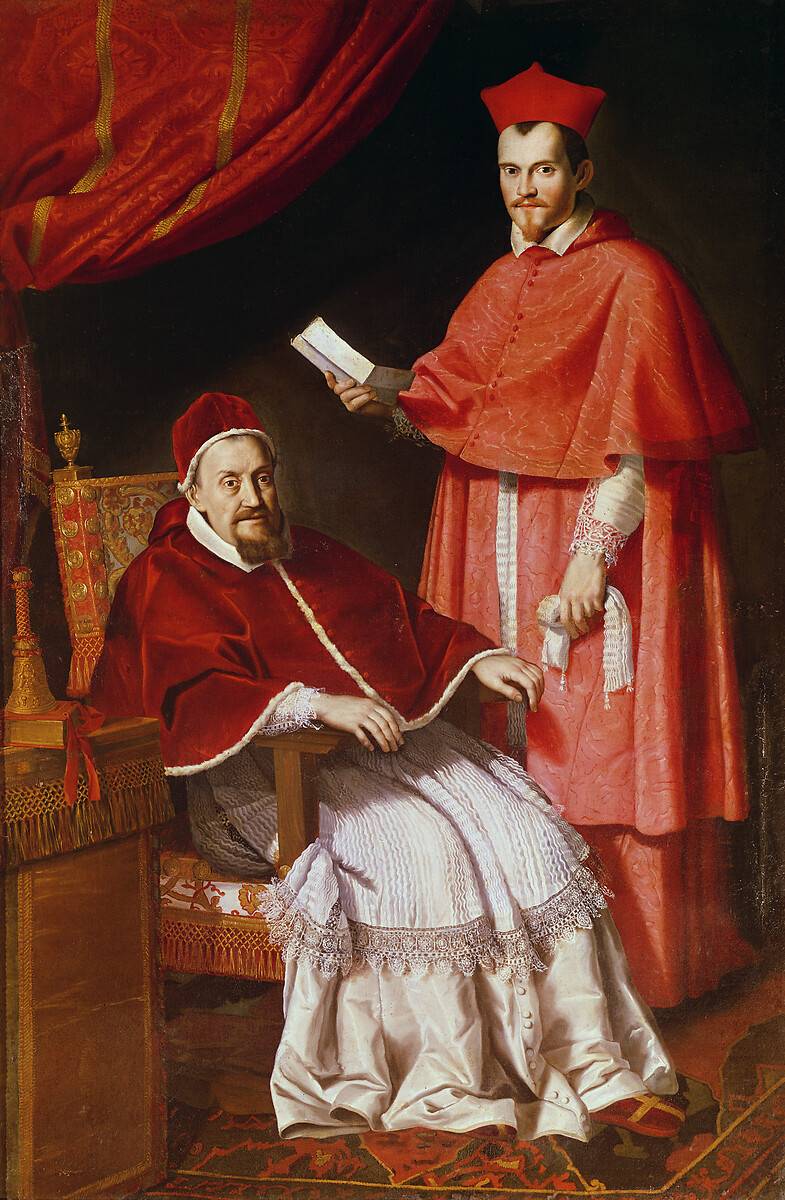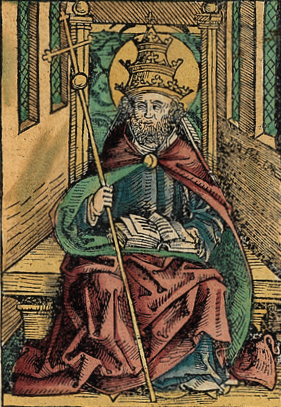|
Buenaventura Fernández De Córdoba Spínola
Buenaventura Fernández de Córdoba-Figueroa y Spínola de la Cerda (or Buenaventura Córdoba Espinosa de la Cerda; 23 February 1724 – 6 January 1777) was a Spanish aristocrat and Catholic priest who became Patriarch of the West Indies and a Cardinal. Family Buenaventura Fernández de Córdoba Spínola de la Cerda was born on 23 February 1724, the fifth of a family of seven children. His full baptismal name was Buenaventura Francisco de Sales Antonio Ramón Pascual Pío Bibiano María de la Soledad Juan de Mata Luis Alfonso de la Concepción Policarpo Venancio Diego José Francisco de Asís. His parents were Nicolás María Fernández de Córdoba Figueroa de la Cerda, 9th Marquis of Priego, Villafranca and Montalbán, Duke of Feria and 10th Duke of Medinaceli, and Jerónima María Spínola de la Cerda. His father was one of the most powerful and wealthy men in 18th century Spain, who had inherited the house of Priego and Feria from his father, and the Duchy of Medinaceli aft ... [...More Info...] [...Related Items...] OR: [Wikipedia] [Google] [Baidu] |
Patriarchate Of The West Indies
The Titular Patriarchate of the West Indies ( la, Patriarchatus Indiarum Occidentalium) is a Latin Rite titular patriarchate of the Roman Catholic Church. It is vacant since the death of its last holder in 1963."Patriarchate of West Indies" ''''. David M. Cheney. Retrieved February 29, 2016"Titular Patriarchal See of Indias Occidentales" ''GCatholic.org''. Gabriel Chow. Retrieved February 29, 2016 Attempt to create a jurisdictional Patriarc ...
|
Niksar
Niksar, historically known as Neocaesarea (Νεοκαισάρεια), is a city in Tokat Province, Turkey. It was settled by many empires, being once the capital city of the province. Niksar is known as "Çukurova of the North-Anatolia" due to its production of many kinds of fruits and vegetables except citrus fruits. On May 2, 2018, Niksar was included in the World Heritage tentative list. History Niksar has been ruled by the Hittite, Persian, Greek, Pontic, Roman, Byzantine, Danishmend, Seljuk and Ottoman Empires. It has always been an important place in Anatolia because of its location, climate and productive farmland. It was known as Cabira in the Hellenistic period ( in Greek). It was one of the favourite residences of Mithridates the Great, who built a palace there, and later of King Polemon I and his successors.Catholic Encyclopedia, 1907, ''s.v.'' Neocaesarea In 72 or 71 BCE, the Battle of Cabira during the Third Mithridatic War took place at Cabira, and the city pa ... [...More Info...] [...Related Items...] OR: [Wikipedia] [Google] [Baidu] |
Ludovico Ludovisi
Ludovico Ludovisi (22 or 27 October 1595 – 18 November 1632) was an Italian Cardinal (Catholic Church), cardinal and statesman of the Roman Catholic Church. He was an art connoisseur who formed a famous collection of antiquities, housed at the Villa Ludovisi in Rome. Biography Ludovico Ludovisi was born in Bologna, then part of the Papal States, the son of Orazio Ludovisi and Lavinia Albergati. Following in the footsteps of his uncle Alessandro Ludovisi, he was trained at the Jesuit Collegio Germanico of Rome, and went on to the University of Bologna, where he received his doctorate in canon law on 25 February 1615. When Alessandro Ludovisi was acclaimed pope, taking the name Pope Gregory XV, Gregory XV, Ludovico was made cardinal the day after his coronation, though he was only 25. The following month he was made archbishop of Bologna though he remained in Rome. His uncle had great faith in his judgement and energy and was in need of a strong and able assistant to help gov ... [...More Info...] [...Related Items...] OR: [Wikipedia] [Google] [Baidu] |
Galeazzo Sanvitale
Galeazzo Sanvitale (died 8 September 1622) was a Roman Catholic prelate who served as Archbishop of Bari-Canosa (1604–1606). ''(in Latin)''"Archbishop Galeazzo Sanvitale" ''''. David M. Cheney. Retrieved March 21, 2016. Biography Galeazzo Sanvitale was born in Parma, Italy in 1566. On 15 March 1604, he was appointed during the papacy of as[...More Info...] [...Related Items...] OR: [Wikipedia] [Google] [Baidu] |
Dominican Order
The Order of Preachers ( la, Ordo Praedicatorum) abbreviated OP, also known as the Dominicans, is a Catholic mendicant order of Pontifical Right for men founded in Toulouse, France, by the Spanish priest, saint and mystic Dominic of Caleruega. It was approved by Pope Honorius III via the papal bull ''Religiosam vitam'' on 22 December 1216. Members of the order, who are referred to as ''Dominicans'', generally carry the letters ''OP'' after their names, standing for ''Ordinis Praedicatorum'', meaning ''of the Order of Preachers''. Membership in the order includes friars, nuns, active sisters, and lay or secular Dominicans (formerly known as tertiaries). More recently there has been a growing number of associates of the religious sisters who are unrelated to the tertiaries. Founded to preach the Gospel and to oppose heresy, the teaching activity of the order and its scholastic organisation placed the Preachers in the forefront of the intellectual life of the Middle Ag ... [...More Info...] [...Related Items...] OR: [Wikipedia] [Google] [Baidu] |
Girolamo Bernerio
Girolamo Cardinal Bernerio, O.P. (1540 – 5 August 1611) was an Italian Cardinal of the Roman Catholic Church. Biography Bernerio was born in Corregio. He served as Bishop of Ascoli Piceno from 1586 until his resignation in 1605. He was elevated to Cardinal on 16 November 1586 and installed as the Cardinal-Priest of S. Tommaso in Parione the following year. He subsequently became the Cardinal-Priest of S. Maria sopra Minerva (1589), the Cardinal-Priest of S. Lorenzo in Lucina (1602), the Cardinal-Bishop of Albano (1603) and the Cardinal-Bishop of Porto e Santa Rufina (1607)."Cardinal Girolamo Bernerio" ''GCatholic.org''. Gabriel Chow. Retrieved April 30, 2016 On 7 September 1586, Bernario was consecrated to ... [...More Info...] [...Related Items...] OR: [Wikipedia] [Google] [Baidu] |
Giulio Antonio Santorio
Giulio Antonio Santorio (6 June 1532 – 9 May 1602) was an Italian Cardinal of the Roman Catholic Church. Biography Santorio was born in Caserta. He served as Archbishop of Santa Severina from 1566 until his death."Giulio Antonio Cardinal Santorio" ''''. David M. Cheney. Retrieved April 30, 2016"Cardinal Giulio Antonio Santorio" ''GCatholic.org''. Gabriel Chow. Retrieved April 30, 2016 On 12 March 1566, Santorio was |
Scipione Rebiba
Scipione Rebiba (3 February 1504 – 23 July 1577) was an Italian prelate of the Catholic Church, a protégé of Gian Pietro Carafa, who became Pope Paul IV. He held a variety of positions in the Church hierarchy, including some of the most senior. He introduced the Inquisition to Naples in the 1550s and became a cardinal in 1555. He is mostly known today for having been the earliest bishop to whom most Roman Catholic bishops can trace their apostolic succession, as it is unknown who consecrated Rebiba. Biography Scipione Rebiba was born on 3 February 1504 in the village of San Marco d'Alunzio, in Sicily. He studied in Palermo and enjoyed a benefice in the Church of S. Maria dei Miracoli. On 16 March 1541, on the recommendation of Bishop Gian Pietro Carafa, Pope Paul III appointed him titular Bishop of Amyclae so he could serve as Carafa's auxiliary bishop in the Diocese of Chieti. On 22 February 1549, Pope Paul III named Carafa Archbishop of Naples, but Emperor Charles ... [...More Info...] [...Related Items...] OR: [Wikipedia] [Google] [Baidu] |
Apostolic Succession
Apostolic succession is the method whereby the ministry of the Christian Church is held to be derived from the apostles by a continuous succession, which has usually been associated with a claim that the succession is through a series of bishops. Those of the Anglican, Church of the East, Eastern Orthodox, Hussite, Moravian, Old Catholic, Oriental Orthodox, Roman Catholic and Scandinavian Lutheran traditions maintain that "a bishop cannot have regular or valid orders unless he has been consecrated in this apostolic succession". These traditions do not always consider the episcopal consecrations of all of the other traditions as valid. This series was seen originally as that of the bishops of a particular see founded by one or more of the apostles. According to historian Justo L. González, apostolic succession is generally understood today as meaning a series of bishops, regardless of see, each consecrated by other bishops, themselves consecrated similarly in a succession ... [...More Info...] [...Related Items...] OR: [Wikipedia] [Google] [Baidu] |
Francisco Javier Delgado Venegas
Francisco is the Spanish and Portuguese form of the masculine given name ''Franciscus''. Nicknames In Spanish, people with the name Francisco are sometimes nicknamed "Paco". San Francisco de Asís was known as ''Pater Comunitatis'' (father of the community) when he founded the Franciscan order, and "Paco" is a short form of ''Pater Comunitatis''. In areas of Spain where Basque is spoken, "Patxi" is the most common nickname; in the Catalan areas, "Cesc" (short for Francesc) is often used. In Spanish Latin America and in the Philippines, people with the name Francisco are frequently called "Pancho". " Kiko" is also used as a nickname, and "Chicho" is another possibility. In Portuguese, people named Francisco are commonly nicknamed " Chico" (''shíco''). This is also a less-common nickname for Francisco in Spanish. People with the given name * Pope Francis is rendered in the Spanish and Portuguese languages as Papa Francisco * Francisco Acebal (1866–1933), Spanish writer and ... [...More Info...] [...Related Items...] OR: [Wikipedia] [Google] [Baidu] |
Apoplexy
Apoplexy () is rupture of an internal organ and the accompanying symptoms. The term formerly referred to what is now called a stroke. Nowadays, health care professionals do not use the term, but instead specify the anatomic location of the bleeding, such as cerebral, ovarian or pituitary. Informally or metaphorically, the term ''apoplexy'' is associated with being furious, especially as "apoplectic". Historical meaning From the late 14th to the late 19th century,''OED Online'', 2010, Oxford University Press. 7 February 2011 ''apoplexy'' referred to any sudden death that began with a sudden loss of consciousness, especially one in which the victim died within a matter of seconds after losing consciousness. The word ''apoplexy'' was sometimes used to refer to the symptom of sudden loss of consciousness immediately preceding death. Ruptured aortic aneurysms, and even heart attacks and strokes were referred to as apoplexy in the past, because before the advent of medical science, the ... [...More Info...] [...Related Items...] OR: [Wikipedia] [Google] [Baidu] |
Charles Emmanuel III Of Sardinia
Charles Emmanuel III (27 April 1701 – 20 February 1773) was Duke of Savoy and King of Sardinia from 1730 until his death. Biography He was born in Turin to Victor Amadeus II of Savoy and his first wife the French Anne Marie d'Orléans. His maternal grandparents were Prince Philippe of France and his first wife Princess Henrietta, the youngest daughter of Charles I of England and Henrietta Maria of France. Charles Emmanuel was the oldest surviving brother of Princess Maria Adelaide of Savoy - the mother of Louis XV of France; he was also the brother of Maria Luisa of Savoy, Queen of Spain as wife Philip V of Spain. At the time of his birth, when he was known as Duke of Aosta, Charles Emmanuel was not the heir to Savoy; his older brother Victor Amadeus, Prince of Piedmont, was the heir apparent. Charles Emmanuel was the second of three sons that would be born to his parents. His older brother died in 1715 and Charles Emmanuel then became heir apparent. As a result of his ... [...More Info...] [...Related Items...] OR: [Wikipedia] [Google] [Baidu] |
.png)



